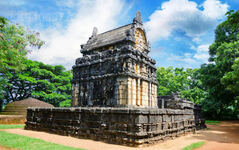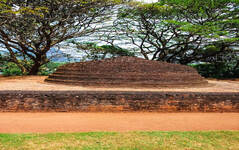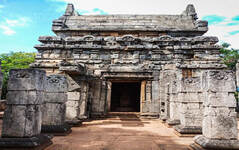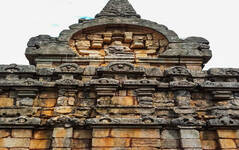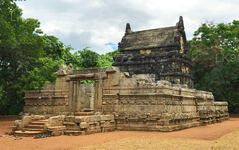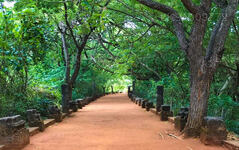Nalanda Gedige
Nalanda Gedige is an ancient and mysterious edifice near Matale that has confounded researchers with its strange mix of Hindu and Buddhist architecture. Believed to be at least a thousand years old the structure; the structure was rediscovered in 1893 by the Archaeological Commissioner of Sri Lanka at the time, H. C. P. Bell.
History
According to what historians and archaeologists have discovered about Nalanda Gedige; the structure was created between the 8th and 10th century AD. This was a turbulent period for olden day Ceylon, with South Indian kings establishing themselves in the wake of the declining Sinhalese monarchy. Some historians conjecture that Nalanda Gedige was a bold attempt at a fusion of Tamil and Sinhalese cultures; while others say the structure started out as a Hindu Temple constructed in the Pallava style, which was later used by Buddhists. Either way, at an unknown point in time, Nalanda Gedige was abandoned and forgotten; its mystery unsolved. The forest took over the region, swallowing the sanctum into its deep, dark embrace.
Many centuries later in 1893, while the British were trying to discover the mysteries of tropical Ceylon; H. C. P. Bell, who was the Archaeological Commissioner at the time, found the edifice in a patch of deep jungle close to a village. Realising its historical importance; he then made a concentrated effort to research it, and acquired the surrounding land for that sole purpose. One of his journals stated the following:
"land was acquired round this little-known and solitary shrine of granite construction, popularly styled gedige. It is situated on raised ground in paddy fields, picturesquely surrounded by low hills and wooded hamlets. In 1911 a small gang was detached from the labor force at Sigiriya to thoroughly root out all the jungle growth upon and around the ruin besides cutting still further back the earth silt hiding the bold stylites upon which the fane stands. Very special importance attaches to this unique temple, as it is the sole example yet discovered in Ceylon of composite styles of architecture judiciously blended to form a delightfully homogeneous edifice."
Bell also had plans to dismantle and relocate the entire structure to a more viable location. He felt that the temple was in a precarious location; an elevated area that might become unstable at any moment, causing Nalanda Gedige irretrievable damage. However his plans did not achieve fruition until many years later, when he had long since moved on from the position of Archaeological Commissioner.
In the 1980s, the waters of the newly created Bowatenne Tank threatened to flood the shrine. Therefore, researchers took the opportunity to dismantle the ruin and rebuild it on the retaining wall of the tank, high above the waters. It was reconstructed beside the tank, and can now be approached by a flower-edged causeway with a magnificent backdrop of tree-clad hills.
Architecture
Nalanda Gedige was designed in the standard framework of a Hindu temple; with a mandapams or halls used for events, an entrance passage which was originally roofed, a main central shrine, and an ambulatory round this holy center. The image is quite contradictory though as there has been no sign of Hindu Gods found within the temple, and there were unusual elements not found in a standard South Indian style Hindu temple. For example, the richly decorated facade sections is believed to be of South Indian design from the era of the Cholas and Pandyas; but the appearance of the god of wealth, Kubera, seated on a lotus plinth in the a semi-circular niche on the southern section, is a feature only to be found in Sri Lanka. There are also eroded Tantric Buddhist carvings of an erotic tone, much like the famous ones at Khajuraho in India. An esteemed researcher, Roland Raven-Hart, described this hybridisation while writing in Ceylon: History in Stone (1964) as follows:
"Elsewhere there are plenty of Hindu buildings, and plenty of Buddhist ones, and some muddled mongrels; but here the styles are interwoven. The ground-plan is Buddhist, the vestibule pure Hindu and so is the little windowless shrine: the plain moonstone and crocodile balustrade and rivers of dwarfs and architrave of the doorway are Sinhalese, and jambs Tamilian; even the sculptures are fairly shared. The whole effect is charming and for me unexpectedly classical, nor did I find the exterior "over-richly decorated" as did Bell, though it is crowded with pilasters and horseshoe false windows and more jolly dwarfs. And the dome must have been a worthy climax when all its four faces were present, each with horseshoe niche and statue, instead of the one only which was found."
The Edifice Today
Nalanda Gedige can be see not far from Kandy city; and is an important archaeological site of Sri Lanka. It’s not to be missed both for its uniqueness and the mystery it holds. It would definitely help to read up on classical Hindu Temple architecture and Tantric Buddhist architecture, so as to understand the anomaly that is Nalanda Gedige.

